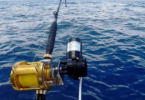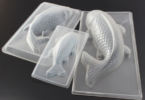Electric fish scalers have revolutionized the way we prepare seafood, offering a faster, more efficient alternative to traditional manual methods. In culinary practices worldwide, the process of scaling fish is crucial for enhancing flavor, texture, and presentation. However, manual scaling can be time-consuming and labor-intensive, limiting the efficiency of kitchen operations.
The introduction of electric fish scalers addresses these challenges by streamlining the scaling process, allowing chefs and home cooks alike to scale fish with ease and precision. By harnessing the power of electricity, these innovative tools automate the scaling task, significantly reducing preparation time while ensuring consistent results.
The importance of efficient fish scaling cannot be overstated in culinary practices. Removing fish scales not only improves the aesthetics of the dish but also facilitates even cooking and enhances the absorption of marinades and seasonings. Whether preparing delicate fillets or whole fish, achieving perfectly scaled seafood is essential for elevating the dining experience.
In this article, we delve into the evolution of fish scaling tools, tracing their development from traditional methods to the cutting-edge electric scalers used today. Join us as we explore the history, functionality, and benefits of electric fish scalers, revolutionizing the way we approach seafood preparation in modern kitchens.
Table of Contents
ToggleHistorical Evolution of Fish Scaling Tools
Throughout history, the process of scaling fish has evolved from primitive methods to innovative tools driven by technological advancements.
Primitive methods of fish scaling: In ancient times, fish were often scaled using rudimentary techniques such as scraping the fish against rough surfaces like rocks or using sharp implements like knives or shells to manually remove scales. While effective to some extent, these methods were time-consuming and labor-intensive, limiting the efficiency of fish preparation.
Introduction of manual fish scaling tools: The introduction of manual fish scaling tools marked a significant advancement in seafood preparation.
These tools, such as handheld scalers with serrated edges or brushes, offered a more efficient alternative to primitive methods, allowing for quicker scaling while minimizing damage to the fish’s skin. However, manual scaling still required considerable effort and precision on the part of the user.
The emergence of electric fish scalers and their impact on the fishing industry: The emergence of electric fish scalers revolutionized the fishing industry by automating the scaling process and drastically reducing preparation time. These electric tools utilize high-speed rotating blades or abrasive discs to rapidly remove scales from the fish’s skin with minimal effort. By harnessing the power of electricity, these scalers offer unparalleled speed, efficiency, and consistency, making them indispensable tools in commercial fisheries and professional kitchens worldwide.
Electric fish scalers have not only streamlined the fish scaling process but have also improved overall productivity and profitability in the fishing industry.
With their ability to scale large quantities of fish quickly and effortlessly, electric scalers have become essential equipment for fishermen, seafood processors, and culinary professionals seeking to optimize efficiency and quality in seafood preparation.
Understanding Electric Fish Scalers
Electric fish scalers operate on a simple yet effective principle, utilizing electricity to power rotating mechanisms that swiftly remove scales from the fish’s skin.
Explanation of how electric fish scalers work: These scalers typically consist of a handheld device with a motorized head equipped with either high-speed rotating blades or abrasive discs.
When activated, the motor generates rotational force, causing the blades or discs to rapidly spin. As the scaler is pressed against the fish’s skin, the rotating blades or discs come into contact with the scales, effectively dislodging them from the surface.
Components and mechanisms involved: The main components of an electric fish scaler include the motor, housing, handle, and interchangeable scaling heads.
The motor provides the necessary power to drive the rotational motion of the scaling head, while the housing and handle provide stability and ergonomic support for the user.
Interchangeable scaling heads may vary in size and design to accommodate different types and sizes of fish.
Advantages over traditional manual scalers: Electric fish scalers offer several advantages over traditional manual scalers. Firstly, they significantly reduce scaling time, allowing for faster and more efficient fish preparation. Additionally, electric scalers require less physical effort, minimizing fatigue and strain on the user’s hands and wrists.
The consistent rotational motion of the scaling head ensures uniform scaling results, resulting in cleaner and more aesthetically pleasing fish fillets. Moreover, electric scalers are versatile tools that can be used on a wide range of fish species, from small panfish to large game fish, making them indispensable equipment for both commercial and recreational fishermen.
In summary, electric fish scalers provide a convenient and effective solution for scaling fish, offering speed, efficiency, and consistency unmatched by traditional manual methods.
Comparison of Electric Fish Scalers
When comparing electric fish scalers, several common features can be found among the top products on the market. These features include:
- Motor Power: Most electric fish scalers are equipped with high-torque motors that provide efficient scaling performance. The power of the motor determines the speed and effectiveness of scaling, with higher-powered motors being able to tackle tougher scales more effectively.
- Scaling Head: Stainless steel scaling heads are a common feature among electric fish scalers due to their durability and effectiveness in removing scales. Some scalers may offer interchangeable scaling heads to accommodate different fish sizes and species.
- Variable Speed Control: Many electric fish scalers come with variable speed settings, allowing users to adjust the scaling speed according to their preferences and the type of fish being scaled. This feature offers greater control and precision during the scaling process.
- Ergonomic Design: A comfortable and ergonomic design is essential for prolonged use, especially in commercial settings. Features such as anti-slip handles and lightweight construction contribute to user comfort and reduce fatigue during operation.
- Safety Features: Blade guards and splash-proof designs are commonly incorporated into electric fish scalers to ensure user safety during operation. These features help prevent accidents and minimize the risk of injury.
While electric fish scalers share many common features, there are key differences and factors to consider when choosing the right one for your needs. These include:
- Price: Electric fish scalers vary in price, ranging from budget-friendly options to more premium models with advanced features. Consider your budget and how often you will be using the scaler to determine the best value for your money.
- Portability: Cordless electric fish scalers offer greater mobility and convenience, making them ideal for outdoor fishing trips. However, corded models may provide more consistent power for heavy-duty scaling tasks.
- Durability: Look for electric fish scalers made from high-quality materials such as stainless steel and durable plastics. A robust construction ensures long-term reliability and performance, especially in commercial settings.
- Scaling Capacity: Consider the size and type of fish you will be scaling regularly to ensure that the scaler you choose can accommodate your needs. Some scalers may be better suited for smaller fish, while others are designed for larger or tougher-scaled species.
By comparing these factors and considering your specific requirements, you can select the electric fish scaler that best meets your needs and preferences. Whether you’re a professional chef, avid fisherman, or home cook, investing in a quality electric fish scaler can streamline the fish preparation process and enhance the quality of your seafood dishes.
Pros and Cons of Using Electric Fish Scalers
Electric fish scalers offer several advantages that make them popular among chefs, fishermen, and seafood enthusiasts. However, they also come with limitations and considerations that users should be aware of.
Advantages:
- Efficiency: Electric fish scalers can significantly reduce scaling time compared to manual methods, allowing for faster fish preparation in commercial kitchens or during fishing trips.
- Consistency: Electric scalers provide uniform scaling results, ensuring that fish are evenly descaled without damaging the skin or flesh.
- Ease of Use: Electric scalers are generally easy to operate, requiring minimal effort from the user. This makes them suitable for individuals with limited hand strength or dexterity.
- Versatility: Many electric fish scalers come with interchangeable heads or variable speed settings, allowing users to scale different types and sizes of fish with ease.
- Safety Features: Most electric scalers are equipped with safety features such as blade guards and splash-proof designs to prevent accidents and protect users from injuries.
Limitations and Drawbacks:
- Cost: Electric fish scalers can be more expensive than manual scaling tools, which may deter some users, especially those on a tight budget.
- Maintenance: Electric scalers require regular cleaning and maintenance to ensure optimal performance and longevity. Neglecting maintenance can lead to reduced efficiency and potential safety hazards.
- Power Source: Corded electric scalers require access to a power outlet, limiting their mobility and versatility compared to cordless models, especially during outdoor fishing trips.
- Noise: Some electric fish scalers can be noisy during operation, which may be disruptive in quiet environments or sensitive settings.
Safety Considerations:
- Sharp Blades: Electric fish scalers utilize sharp blades or abrasive discs to remove scales, posing a risk of cuts or injuries if not handled properly. Users should exercise caution when operating the scaler and always use protective gear such as gloves.
- Electrical Hazards: Users should follow manufacturer instructions and safety guidelines when using electric fish scalers to minimize the risk of electrical shocks or malfunctions.
- Cleaning: Electric scalers should be cleaned and maintained regularly to prevent buildup of fish scales, debris, or bacteria, which can compromise hygiene and safety.
Overall, electric fish scalers offer numerous benefits in terms of efficiency, consistency, and ease of use. However, users should be aware of their limitations and take appropriate safety precautions to ensure a positive and safe scaling experience.
Preparing Fish for Scaling
Before scaling fish, it’s essential to properly handle and clean the fish to ensure food safety and optimal scaling results.
- Handling Techniques:
- Start by handling the fish with clean hands and on a clean surface to prevent contamination.
- Remove any packaging or wrapping from the fish and place it on a cutting board.
- If scaling whole fish, ensure that the fish is gutted and cleaned thoroughly to remove any internal organs or debris.
- Cleaning Techniques:
- Rinse the fish under cold running water to remove any surface impurities or residue.
- Use a sharp knife to trim off any fins or protruding parts that may interfere with scaling.
- Pat the fish dry with paper towels to remove excess moisture, which can make scaling more difficult.
- Safety Precautions:
- Wear protective gloves to prevent cuts or injuries when handling sharp objects such as fish scales or knives.
- Use a sturdy cutting board and keep knives sharp to minimize the risk of slips or accidents.
- Avoid cross-contamination by cleaning cutting boards, utensils, and surfaces thoroughly after handling raw fish.
By following proper handling and cleaning techniques and observing safety precautions, you can ensure that your fish is properly prepared for scaling, resulting in a safe and efficient scaling process with optimal results.
Using an Electric Fish Scaler
Operating an electric fish scaler is straightforward, but following a step-by-step guide can help ensure safe and efficient scaling.
Step-by-Step Guide:
- Prepare the Fish: Ensure the fish is properly handled and cleaned before scaling. Remove any packaging, fins, and protruding parts that may interfere with scaling.
- Assemble the Electric Fish Scaler: If necessary, attach the scaling head to the scaler according to manufacturer instructions. Ensure the scaler is securely assembled and ready for use.
- Power On the Scaler: Plug in the corded scaler or ensure the battery is fully charged for cordless models. Turn on the scaler using the power switch or button.
- Position the Scaler: Hold the scaler firmly with one hand and position the scaling head against the fish’s skin at a slight angle. Ensure the scaler is stable and in contact with the fish’s scales.
- Activate the Scaler: Press the trigger or button to activate the scaler’s motor. The rotating blades or discs will start to spin, effectively removing scales from the fish’s skin.
- Move the Scaler: Move the scaler in a steady and controlled motion along the fish’s body, covering all areas that require scaling. Apply gentle pressure to ensure thorough scaling without damaging the fish’s skin.
- Inspect and Repeat: Periodically stop to inspect the scaling progress and adjust as needed. Continue scaling until all scales are removed from the fish’s skin.
- Power Off and Clean: Once scaling is complete, turn off the scaler and disconnect it from the power source. Remove any detachable parts, such as the scaling head, and clean them thoroughly according to manufacturer instructions.
Tips for Efficient Scaling:
- Start with the areas with thicker scales or tough spots.
- Work systematically from one end of the fish to the other to ensure thorough scaling.
- Use short, overlapping strokes for even scaling coverage.
- Maintain a consistent angle and pressure throughout the scaling process.
- Regularly clean the scaling head to prevent the buildup of fish scales and debris, which can affect performance.
By following these steps and tips, you can efficiently and safely scale fish using an electric fish scaler, resulting in clean and ready-to-cook seafood for your culinary creations.
Cleaning and Maintenance
Proper cleaning and maintenance are essential to prolong the lifespan and ensure optimal performance of your electric fish scaler.
Cleaning After Use:
- Disconnect from Power: Before cleaning, always disconnect the scaler from the power source to prevent accidents.
- Remove Detachable Parts: If applicable, remove any detachable parts such as the scaling head or blades from the scaler.
- Rinse with Water: Rinse the scaler and detachable parts under running water to remove any fish scales, debris, or residue.
- Use Mild Detergent: Apply a small amount of mild detergent to a soft brush or sponge and gently scrub the scaler and parts to remove stubborn stains or buildup.
- Thoroughly Dry: After cleaning, thoroughly dry the scaler and parts with a clean towel or cloth to prevent rust or corrosion.
- Reassemble: Once dry, reassemble the scaler and ensure all parts are securely attached according to manufacturer instructions.
- Store Properly: Store the scaler in a cool, dry place away from direct sunlight and moisture to prevent damage.
Maintenance Tips:
- Sharpen Blades: Regularly sharpen the blades or abrasive discs of the scaler to maintain optimal cutting performance. Use a sharpening stone or professional sharpening service for best results.
- Lubricate Moving Parts: Apply a small amount of lubricant to any moving parts or mechanisms of the scaler to ensure smooth operation and prevent friction-related wear.
- Inspect for Damage: Periodically inspect the scaler for any signs of damage, wear, or malfunction. Replace any damaged or worn parts promptly to avoid further issues.
- Follow Manufacturer Instructions: Refer to the manufacturer’s instructions and guidelines for specific maintenance recommendations tailored to your electric fish scaler model.
- Avoid Exposure to Water: Minimize exposure to water and moisture, especially in electrical components, to prevent damage and electrical hazards.
- Handle with Care: Handle the scaler with care and avoid dropping or mishandling it, as this can cause damage to internal components or affect performance.
By following these cleaning and maintenance instructions, you can ensure that your electric fish scaler remains in optimal condition, providing reliable and efficient scaling performance for years to come.
Safety Measures
Following safety guidelines when using an electric fish scaler is crucial to prevent accidents and ensure a safe scaling experience.
Importance of Following Safety Guidelines:
- Prevent Injuries: Electric fish scalers utilize sharp blades or abrasive discs, posing a risk of cuts or injuries if not handled properly. Following safety guidelines minimizes the risk of accidents and injuries during operation.
- Ensure Food Safety: Proper handling and cleaning techniques, as well as adherence to safety precautions, help prevent cross-contamination and ensure the safety and quality of the scaled fish for consumption.
- Protect Equipment: Following safety guidelines can also help protect the electric fish scaler from damage or malfunction, prolonging its lifespan and maintaining optimal performance.
Potential Risks and How to Mitigate Them:
- Sharp Blades: The sharp blades or abrasive discs of electric fish scalers can cause cuts or injuries if mishandled. To mitigate this risk, always wear protective gloves when operating the scaler and handle it with care to avoid accidental contact with the blades.
- Electrical Hazards: Electric fish scalers pose a risk of electrical shocks or malfunctions if not used properly. To reduce this risk, always follow manufacturer instructions and safety guidelines, and avoid exposing the scaler to water or moisture.
- Slips and Falls: Slips and falls can occur if the scaler or surrounding area is wet or slippery. To prevent accidents, ensure the work area is clean and dry, and use a sturdy surface or non-slip mat to secure the scaler during operation.
By understanding the potential risks associated with electric fish scalers and following safety guidelines, users can mitigate these risks and ensure a safe and efficient scaling process.
Environmental Impact
When considering the environmental impact of electric fish scalers, sustainability and environmental considerations play a significant role in their use compared to traditional scaling methods.
Electric fish scalers offer several potential environmental benefits:
- Reduced Waste: Electric scalers can scale fish more efficiently than manual methods, resulting in less waste during the preparation process.
- Conservation of Resources: By automating the scaling process, electric scalers can help conserve water and energy compared to manual scaling methods, which may require more resources.
- Improved Efficiency: The efficiency of electric scalers can lead to reduced time and labor required for fish preparation, potentially lowering the carbon footprint associated with seafood production.
However, it’s essential to consider the environmental impact of manufacturing and disposing of electric fish scalers, including energy consumption, resource extraction, and waste generation.
When compared to traditional scaling methods, electric fish scalers may have a lower environmental impact due to their efficiency and potential resource savings. Manual scaling methods may require more water, energy, and labor, leading to higher environmental costs.
Overall, electric fish scalers offer the potential for improved sustainability and reduced environmental impact compared to traditional scaling methods, but it’s essential to consider the full lifecycle of the equipment and its environmental footprint.
FAQs
How do electric fish scalers work?
Electric fish scalers operate by utilizing a high-speed motor to power rotating blades or abrasive discs. When the scaler is activated, the motor generates rotational force, causing the blades or discs to spin rapidly. As the scaler is pressed against the fish’s skin, the rotating blades or discs come into contact with the scales, effectively dislodging them from the surface. This automated process significantly reduces scaling time and effort compared to manual methods, resulting in faster and more efficient fish preparation.
Are electric fish scalers safe to use?
Yes, electric fish scalers are generally safe to use when operated according to manufacturer instructions and safety guidelines. Most electric scalers are equipped with safety features such as blade guards and splash-proof designs to prevent accidents and protect users from injuries. However, users should exercise caution when handling sharp blades and always use protective gear such as gloves when operating the scaler. Additionally, users should follow proper cleaning and maintenance procedures to ensure optimal performance and safety.
Can electric fish scalers handle different types of fish?
Yes, electric fish scalers are designed to handle a wide range of fish species and sizes. Whether scaling delicate fillets or larger game fish, electric scalers offer versatility and efficiency in fish preparation. Many electric scalers come with interchangeable scaling heads or variable speed settings, allowing users to customize the scaling process according to the type and size of fish being scaled. However, users should refer to manufacturer specifications to ensure that the scaler is suitable for their specific needs.
How do I clean and maintain an electric fish scaler?
Cleaning and maintaining an electric fish scaler is essential to ensure optimal performance and longevity. To clean the scaler, first, disconnect it from the power source and remove any detachable parts, such as the scaling head. Rinse the scaling head and housing under running water to remove any fish scales or debris.
Use a mild detergent and a soft brush to gently scrub the scaling head and housing, taking care to avoid damaging any components.
Once cleaned, thoroughly dry the scaler with a clean towel or cloth before reassembling. Regular maintenance tasks may include sharpening blades, lubricating moving parts, and inspecting for any signs of wear or damage. Refer to the manufacturer’s instructions for specific cleaning and maintenance guidelines tailored to your electric fish scaler model.
Conclusion
Electric fish scalers have emerged as indispensable tools in modern fishing practices, offering numerous benefits and revolutionizing the way seafood is prepared.
Their efficiency, speed, and versatility make them invaluable assets for chefs, fishermen, and seafood enthusiasts alike.
Throughout this discussion, we’ve explored the various advantages of electric fish scalers, including their ability to streamline the scaling process, ensure consistent results, and enhance productivity in commercial and home kitchens. By automating the scaling task, electric scalers not only save time and effort but also contribute to improved food safety and quality.
In conclusion, electric fish scalers represent a significant advancement in seafood preparation technology, offering sustainable and efficient solutions for scaling fish.
While they may have environmental considerations, their overall benefits outweigh potential drawbacks, making them essential tools for modern fishing practices.
As technology continues to evolve, electric fish scalers will likely play an increasingly important role in meeting the demands of the seafood industry and satisfying the culinary preferences of consumers worldwide.







Leave a Comment